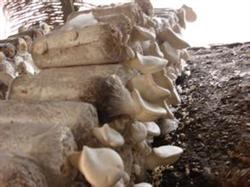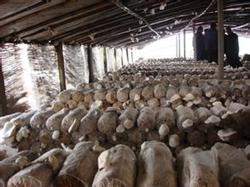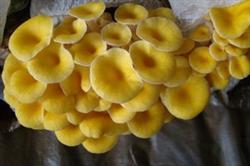Cultivation techniques of Pleurotus ostreatus

The preparation of mushroom rod and the formula of cultivating mushroom rod: (1), cottonseed hull 92%, corn meal 3%, wheat bran 5%, water content 65%. (2), cottonseed hull 70%, corn meal 3%, sawdust 20%, wheat bran 7%, gypsum 2%, quicklime 5%, water content 65%. Preparation before production in Jixian County, the average temperature starts bagging at 20 ℃ in mid-late August, the greenhouse is generally 70 meters long and 9 meters wide, and 15 to 19 tons of cottonseed hulls are prepared. The quantity of other raw materials is calculated according to the formula. 3 to 38000 mushroom sticks can be produced in each shed. If you spread bacteria in the greenhouse, you also need to prepare the plastic film, grass curtain and rope needed for the greenhouse, and sterilize the greenhouse completely, generally spray quicklime and carbendazim and clean up the environment of the mushroom shed. If the old mushroom shed should be sprayed about 500 times the carbendazim germicidal drug. Can also be on the old mushroom shed should be scraped off the wall skin, eradicate the surface soil about 2 centimeters. Exposure to the sun for 7 to 10 days before use. At present, the greenhouse is the best place to infect bacteria. The production of culture materials is usually 1 group for every 3 people, and the ingredients can be about 2000 kg per day. According to the formula, the number of all kinds of main materials or auxiliary materials is the most, and add water, the ratio of material to water is 1 ∶ 1.1 to 1 ∶ 1.4 to mix well. Turning the material for three times and then stuffing it with plastic sheet for about 12 hours to make the water fully soak evenly and produce heat to induce spore germination. Bagging in advance to prepare 1 to 2 bagging machines, (generally choose multi-functional bagging machine, now generally on the market about 350 to 500 yuan each) 8 to 12 people in a group to carry out small-scale flow operation, generally 12 to 14 hours to complete 2000 kg (dry material) rod loading work. One end should be fastened before bagging. Generally speaking, the specifications of Pleurotus ostreatus stick should be 17 to 18 cm, 35 to 40 cm long and 0.05 mm thick. When entering the material, the staff stuffing should be moderate, loose and tight when bagging, the appropriate standard is to gently press the bacterial bag with your fingers, the fingers feel elastic, but not too hard, if you press the bacterial bag with your hand, that is, the indentation is obvious, it indicates that the bag material is loose and should be re-loaded, it is best to use nylon rope or rubber ring, the binding should not be too loose or too tight, rotate twice at the mouth of the bag with string, and then tie a knot to provide convenience for inoculation operation. When moving the plastic bag, the bacterial film ruptured or punctured by sharp objects must be replaced or filled with curtain plastic tape. After sterilization, the sterilization stick must be gently put into the sterilization basket for sterilization. Under normal circumstances, about 4000 sterilization sticks can be sterilized at one time. About 180to200sterilization baskets are needed, and the sterilization baskets are well built in order. In general, the base is 4 to 6 layers wide and 6 to 8 rows wide. The length depends on the number of bacterial rods. And cover it with nylon white cloth or parachute cloth, then cover it with thick plastic sheet. The four sides are strangled with a rope and pressed around with a nylon bag filled with sand. after making the sterilization chamber, a strong thick skin tube is used to connect with the heat source part of the edible fungus boiler. After igniting the boiler, the boiler steam can enter the self-made sterilization chamber, this method is mainly wet-heat sterilization, and it is also the most effective and economical sterilization method. The boiler uses high-quality fuel (such as Datong block). Each sterilization requires 0.5 to 0.8 tons of coal. It is necessary to ensure that there is no shortage of water in the boiler, the insulation chamber is tightly sealed to prevent air leakage, increase the fire immediately after ignition, ensure that the temperature in the sterilization chamber reaches 100 ℃ in 3 to 4 hours, and keep the temperature in the sterilization chamber in the normal sterilization temperature range. The atmospheric pressure sterilization temperature is 95 ℃ to 105 ℃. It should be kept within this sterilization range for 12 to 16 hours. Increase the fire for 30 minutes at the end. After sterilization, when the temperature of the culture material dropped to about 60 ℃, the turnover basket was moved into the cooling chamber and inoculated after cooling. The general choice of vaccination is to feel heavy, the hands are clapping, there is a feeling, rather than the sound of puffing, it is hard to break it into small pieces at will, the surface is aseptic buds, and the high-quality bacteria without pollution are cultivated. When the ambient temperature is between 20 ℃ and 28 ℃, the bacterial bag is naturally cooled and inoculated; if the environment is below 18 ℃, the bacterial bag is cooled to about 30 ℃ while the inoculation is hot to ensure rapid germination. Vaccination personnel should do three things: quickly prop up the mouth of the bag, quickly inoculate, and fasten the mouth of the bag. Inoculation is generally a group of four people, put the cultivated species and bacterial sticks on each side of the inoculation box, each cultivated species can be inoculated with 15 to 20 cultivated bacterial sticks, about 80 in each box, and strictly follow the operation rules during vaccination. Inoculators strictly disinfect with 75% alcohol, and disinfect each box once, it is best to arrange twice as many inoculation facilities and use them in turn. When the temperature is high, in order to enhance the superiority of bacteria, the amount of bacteria should be increased (no more than 15 per bottle) to improve the success rate of inoculation. Send bacteria to put the stick in the shed (or other germ facilities), cover the greenhouse with straw curtains, the greenhouse must have a darker environment, sprinkle a small amount of quicklime in the shed to keep the shed dry, when the temperature is above 20 ℃, it is generally placed no more than 4 layers, with a gap of 50 to 60 cm between each row, in order to facilitate the ventilation and cooling of the environment, and the number of layers can be increased appropriately when the temperature is low. The ambient temperature should be controlled from 20 ℃ to 28 ℃ 3 to 7 days after inoculation. under this condition, the bacterial bag should not be moved as much as possible with less ventilation. 6 to 8 days after inoculation is the mycelium development period, the mycelium begins to eat, and ventilation must be strengthened to ensure the freshness of the ambient air. During this period, you should ensure that the material temperature is 19 ℃ to 22 ℃, the air relative humidity is 60% to 70%, and the hyphae should be cultivated in mild and dark light when ventilated. Special attention should be paid to the material temperature. If the material temperature rises to 32 ℃, it is necessary to turn the stack in time. If the temperature exceeds 38 ℃, the phenomenon of burning and stacking will occur, and the bad phenomenon of mycelium shrinkage and stop growth will occur, resulting in no mushroom or low yield. It is found that the temperature of the material room is too high, the ventilation rate should be increased and the ambient temperature should be reduced. The process of bacteria generation should be dark culture, suitable temperature, sufficient oxygen and dry environment. When it is found that the bag produces miscellaneous bacteria or small-scale contamination, immediately use a syringe to inject high concentration of lime water or antibiotics to kill the miscellaneous bacteria in the bud. In general, the sticks are all eaten in 25 to 35 days, and the sticks are pure white. After about 35 to 40 days, it matured and a thick skin appeared on the surface of the stick. As long as the hyphae are strong, strong and white, the aseptic skin will produce mushrooms as usual, but the thick skin will delay the emergence of mushrooms. In order to reduce the production of mycelium skin, the ambient temperature should not exceed 28 ℃ and the temperature of bacterial bag should not exceed 30 ℃ during the mycelial growth period. After the mycelium grew in the bag, the surrounding environment should not exceed 20 ℃, and the material temperature should not exceed 25 ℃. After the mycelium grew full, it quickly entered the mushroom stage. Scratching the bacteria stick to the post-ripening stage to scratch the bacteria, so that the mushroom is more concentrated, generally in the scratching place to produce mushrooms, scratching bacteria reveal fresh mycelium, the dug-up mass should not be too large or too small. In order to reduce the loss of water at both ends of the stick, fasten the bag immediately after digging, but it should not be too tight. After scratching the bacteria, hot and cold stimulation is carried out when there are white fimbriae at both ends of the stick. The stimulation gives the greenhouse 0 ℃ to 15 ℃ low temperature stimulation, and the most suitable stimulation temperature is 6 ℃ to 12 ℃. The specific method is to open the film vent of the side door of the greenhouse at night, increase the ventilation rate, stimulate with scattered light during the day, and adjust the humidity in the greenhouse to about 75% to 80%. Mechanical electromagnetic waves and other stimulation can also be used, generally after about 10 days to appear massive, gear-shaped primordium. When low temperature stimulation exceeds 20 ℃, it is difficult to differentiate into fruiting bodies. When the primordium is the size of soybeans, unlock the mouth of the bag in time for pruning, cut off the excess primordium with a sharp knife during pruning, and immediately trim the mouth of the bag when the primordium is the size of broad bean, leaving large to small, strong to weak. When the ping-pong ball pulls up the mouth of the bag, the relative humidity in the shed is adjusted by 85% to 95% and scattered light is given. The light intensity is 600 to 1500 lux, the light time is 12 to 14 hours a day, and the temperature in the greenhouse is raised to 13 ℃ to 18 ℃. The body of Pleurotus ostreatus is usually thick and compact under the condition of 13 ℃ to 18 ℃. Keep the temperature in the shed and make the stalk dwarf. When the concentration of carbon dioxide exceeds 0.4%, it will cause the mushroom stalk to be too long and grow into a long white handle shape, resulting in a decline in quality and affecting the value of the commodity. It takes 10 to 15 days for Pleurotus ostreatus to be harvested. Pleurotus ostreatus can be harvested when the edge of Pleurotus ostreatus cover is about to be wound up. Each Pleurotus ostreatus is 150 to 300 grams, the diameter of the cap is 8 to 15 cm, the thickness of the cap is 6 to 10 cm, and the stalk is less than 2 cm, which is the most suitable for picking. Stop spraying water the day before harvest and harvest it sooner or later. Bailing mushroom can be roughly divided into three grades, that is, grade A mushroom: the mushroom body is palm-shaped or sessile steamed bun-shaped, the mushroom shape is regular, the mushroom body is white, the diameter of the cap is 8 to 15 cm, each is 150 to 200 grams, the cover surface is smooth, the edge is round, there are no wrinkles or cracks, and the folds are arranged neatly. For example, the palmate stalk of the hand is less than 2 cm; Class B mushroom: the mushroom body is white, the mushroom shape is basic regular, the diameter of the cap is 8 to 16 cm, each is between 120 and 300 grams, the cap is smooth and corrugated, the cap is basically flat, there are no obvious cracks, the pleats are neatly arranged, and the stalk is less than 2 cm. Grade C mushroom: the mushroom body is white, the mushroom shape is irregular, there are deformed mushrooms, there are small cracks on the cover surface, the edge is warped, spoon-shaped but no obvious disease spot. Wrap the harvested Pleurotus ostreatus in white copy paper and put each piece of Pleurotus ostreatus in a foam box. It can be kept fresh for 7 to 10 days under 10 ℃. It can be kept fresh for 4 to 5 days under 15 ℃, or for 1 month in 0 ℃ to 1 ℃ storage.
- Prev

Method for fermenting culture material of Pleurotus nebrodensis
Pleurotus nebrodensis is a rare mushroom species developed in recent years. Its cultivation technology is becoming more and more mature, and the commodity of its products is getting higher and higher. I believe that in the near future, Pleurotus nebrodensis will become an ordinary member of the edible mushroom family like Flammulina velutipes and Coprinus comatus, and will be widely cultivated by mushroom farmers. From the looks of it, white spirit...
- Next

Problems needing attention in the production of Pleurotus ostreatus
Pleurotus ostreatus, due to the recent high market price, there are more and more growers, but due to the low conversion rate of Pleurotus ostreatus, only one tide of mushroom is collected, the nutrition in the waste rods after production is still very rich, if it can not be recycled, it not only causes a waste of resources, but also pollutes the environment.
Related
- Fuxing push coffee new agricultural production and marketing class: lack of small-scale processing plants
- Jujube rice field leisure farm deep ploughing Yilan for five years to create a space for organic food and play
- Nongyu Farm-A trial of organic papaya for brave women with advanced technology
- Four points for attention in the prevention and control of diseases and insect pests of edible fungi
- How to add nutrient solution to Edible Fungi
- Is there any good way to control edible fungus mites?
- Open Inoculation Technology of Edible Fungi
- Is there any clever way to use fertilizer for edible fungus in winter?
- What agents are used to kill the pathogens of edible fungi in the mushroom shed?
- Rapid drying of Edible Fungi

